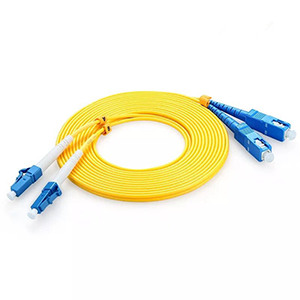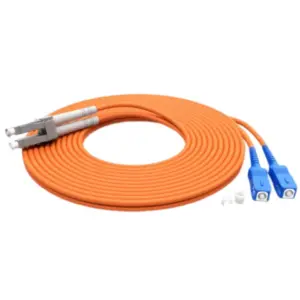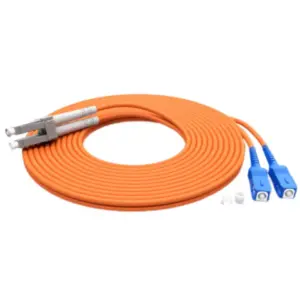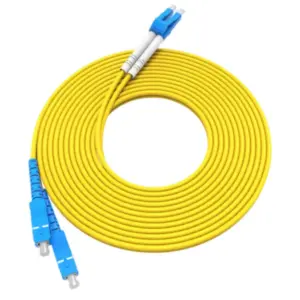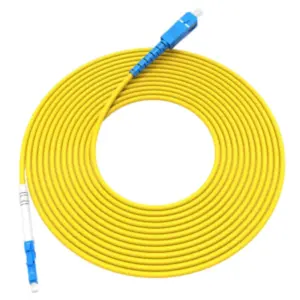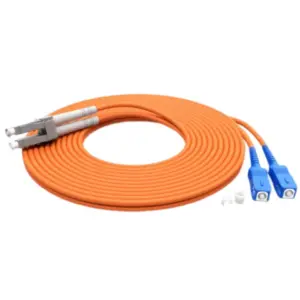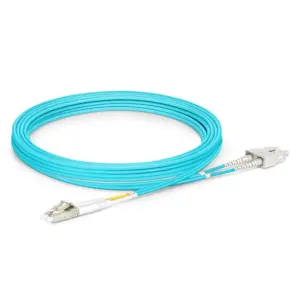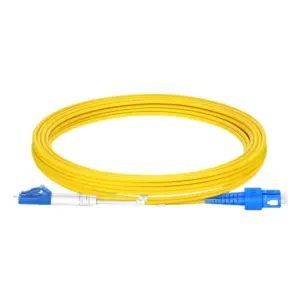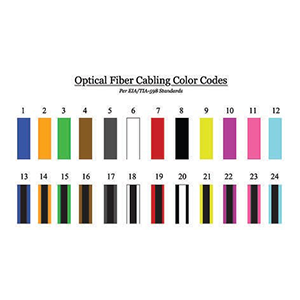Hello everyone! I believe you must be familiar with the wide application of SC and LC fiber optic connectors in fiber optic networks. As two common types of fiber optic connectors, SC and LC each have different characteristics and play an important role in different scenarios. Today I am very happy to provide you with an in-depth explanation of the key role of SC to LC fiber optic patch cord and its important value in connecting different types of equipment.
SC and LC Fiber Optic Connectors Overview
Let me introduce to you two common fiber optic connectors, SC and LC, and their applications in different fiber optic network scenarios:
What are the characteristics of SC and LC fiber optic connectors:
- SC (Subscriber Connector) connector: adopts a cylindrical structure and is connected by screwing. With larger dimensions, it is suitable for occasions requiring higher coupling strength.
- LC (Lucent Connector) connector: adopts a flat card structure and can be quickly connected by plug-in method. The overall size is small and suitable for occasions requiring high-density wiring.
What are the applications of SC and LC in different scenarios:
- SC connector: widely used in carrier-grade optical fiber networks, such as backbone networks, trunk networks, etc. Suitable for scenarios requiring higher coupling strength and stability.
- LC connector: commonly used in enterprise-level and home-level optical fiber networks, such as FTTH, LAN, etc. Suitable for scenarios requiring high-density wiring and easy operability.
What are the performance differences between SC and LC connectors:
- Size: SC connectors are larger, while LC connectors are more compact.
- Coupling strength: SC’s screw-down connection provides high coupling strength.
- Plug and unplug life: The plug and unplug life of SC is usually slightly lower than that of LC.
- Optical performance: There is not much difference between the two in optical signal transmission indicators.
In general, SC and LC fiber optic connectors each have their own characteristics and applicable scenarios. SC is more suitable for backbone networks that require high stability, while LC is more suitable for enterprise and home fiber optic networks that require high-density cabling. The selection needs to be weighed based on actual application requirements.
The function of SC to LC fiber optic jumper
Let me introduce to you the role and value of SC to LC fiber optic patch cords in fiber optic systems:
What is SC to LC fiber optic patch cord:
- SC to LC fiber optic patch cord is a special fiber optic connection cable.
- Uses an SC connector on one end and an LC connector on the other end.
- It can be used to connect equipment and fiber optic cables using different types of fiber optic connectors.
- Plays the role of bridging and converting different interface types in optical fiber network systems.
The importance of SC to LC jumpers when connecting different types of equipment:
- Usually there will be equipment and cables using SC or LC interfaces in optical fiber networks.
- SC to LC jumpers can be used to interconnect these devices and cables to achieve end-to-end optical transmission.
- Without this jumper, fiber optic connections and communications between devices are impossible.
- Therefore, SC to LC patch cord is a key component for realizing heterogeneous fiber optic network interconnection.
The value of SC to LC patch cords in improving fiber optic network interconnectivity:
- The SC to LC jumper can open up the connection between devices using different connectors.
- Improves the flexibility and compatibility of optical fiber network systems and reduces the limitations of equipment selection.
- It is helpful to optimize the topology structure of the optical fiber network and enhance the overall interconnection capability of the network.
- Improves the scalability of the optical fiber network and facilitates future expansion and transformation.
In general, SC to LC fiber optic patch cord, as a key conversion component, plays an important role in connecting different types of equipment and improving the interconnectivity of fiber optic networks. It helps enhance the flexibility and compatibility of optical fiber network systems and is the key to realizing heterogeneous optical fiber network interconnection.
Technical characteristics of SC to LC fiber optic patch cord
Let me introduce to you in detail the main technical characteristics of SC to LC fiber optic patch cord:
Physical structure and optical properties:
- An optical fiber structure composed of optical fiber core, optical fiber cladding, optical fiber outer sheath, etc.
- One end uses an SC connector and the other end uses an LC connector.
- Connector materials are usually metal or polymer materials with good mechanical strength.
- Optical performance indicators include: insertion loss ≤ 0.3 dB, return loss ≥ 45 dB, etc.
Reliability and ease-of-use features:
- The connector design adopts reliable plug-in or screw-down structure to ensure stable connection.
- The outer sheath material is made of wear-resistant and stretch-resistant polymer materials to enhance mechanical reliability.
- The connection operation is simple and fast, and no professional tools are needed to complete the connection.
- A variety of color options are provided to facilitate the identification and management of jumpers for different purposes.
Key technical indicators and their significance:
- Insertion loss (IL): ≤0.3 dB, ensuring optical signal transmission quality.
- Return loss (RL): ≥45 dB, avoid optical signal reflection interference.
- Operating temperature: -40~+75°C, suitable for harsh environmental conditions.
- Bending radius: ≥30 mm, protects optical fiber from excessive bending damage.
- Breaking force: ≥100 N, improving tensile resistance and safety.
To sum up, the SC to LC fiber optic jumper has been optimized in terms of physical structure, optical performance, reliability, etc., and can meet various harsh usage environment requirements in fiber optic networks. The compliance of its key technical indicators ensures the stability and reliability of the jumper in practical applications.
Application scenarios of SC to LC fiber optic patch cord
Let me introduce to you the typical applications of SC to LC fiber optic patch cords in different fiber optic network scenarios:
Data center network application:
- Equipments within data centers often use different fiber optic connector types.
- SC to LC jumper can be used to interconnect devices with SC interface and devices with LC interface.
- Improved utilization flexibility of optical fiber resources within the data center.
Telecom operator backbone network applications:
- SC interface connectors are mostly used for backbone lines in carrier-grade optical fiber networks.
- User-side FTTH and other access networks often use LC interface equipment.
- SC to LC jumpers play a key role in China Unicom’s backbone network and access network.
Building fiber optic cabling applications:
- Fiber optic equipment at different locations within the building may use SC or LC interfaces.
- SC to LC patch cord can flexibly connect these different standards of fiber optic equipment.
- Simplifies equipment selection and cabling deployment of building optical fiber networks.
Important functions of SC to LC jumper:
- By using the SC to LC jumper, the connection between devices using different connectors can be opened up.
- Improves the overall interconnectivity and interoperability of optical fiber network systems and reduces compatibility barriers.
- Enhance the scalability of the network and provide convenience for subsequent transformation and upgrades.
In general, SC to LC fiber optic patch cords play an important role in various fiber optic networks such as data centers, telecommunications networks, and building wiring. It can effectively connect devices using different connector standards, greatly improving the overall interconnectivity and flexibility of optical fiber networks. This is critical to enhance network scalability and compatibility.
Summary
SC to LC fiber optic patch cord is undoubtedly an important part of fiber optic network construction. Its excellent optical performance, ease of use, and key role in connecting different connector devices all highlight the important status of SC to LC jumpers. Whether in the field of data centers, telecommunications networks or building cabling, SC to LC jumpers can inject powerful power into your fiber optic network and ensure efficient interconnection between various types of equipment.
We provide professional fiber patch cables products and related services, and are equipped with an experienced technical team to provide you with considerate guidance at any time. If you have any questions about selecting or using SC to LC jumpers, please feel free to contact us for communication. Let us join hands to open a new era of intelligent fiber optic networks and create a better digital future!
SC To LC Fiber Cable FAQ
An SC to LC fiber optic cable is a type of fiber patch cable that has an SC (Subscriber Connector) connector on one end and an LC (Lucent Connector) connector on the other end. This allows connection between equipment or panels that use different connector types.
The need for SC to LC fiber cables arises when you need to interconnect equipment or infrastructure that utilizes different fiber optic connector types, such as SC and LC. This is common in mixed network environments.
SC to LC fiber cables are commonly used in telecommunications, data centers, enterprise networks, and other fiber optic installations where connectivity between SC and LC equipment or patch panels is required.
The main advantage is the ability to easily connect and integrate equipment with different connector types, enabling greater flexibility and compatibility in fiber optic network deployments.
While both SC and LC connectors are widely used, LC connectors are generally more compact and can provide slightly lower insertion loss and back reflection compared to SC connectors.
SC to LC fiber cables are manufactured with both single-mode and multimode fiber types, depending on the specific network requirements and compatibility needs.
Proper termination of the SC and LC connectors, following the manufacturer’s guidelines, is crucial to ensure the cable’s reliability and performance.
SC to LC fiber cables can be found with various jacket materials, such as PVC, LSZH (Low-Smoke Zero-Halogen), or armored, depending on the environmental and installation requirements.
Labeling the cable ends and implementing appropriate cable management practices are important to maintain organization and traceability in fiber optic installations.
In addition to standard fiber optic tools, specialized tools like connector cleaner and inspection scopes may be required to properly inspect and maintain SC to LC fiber cable connections.

